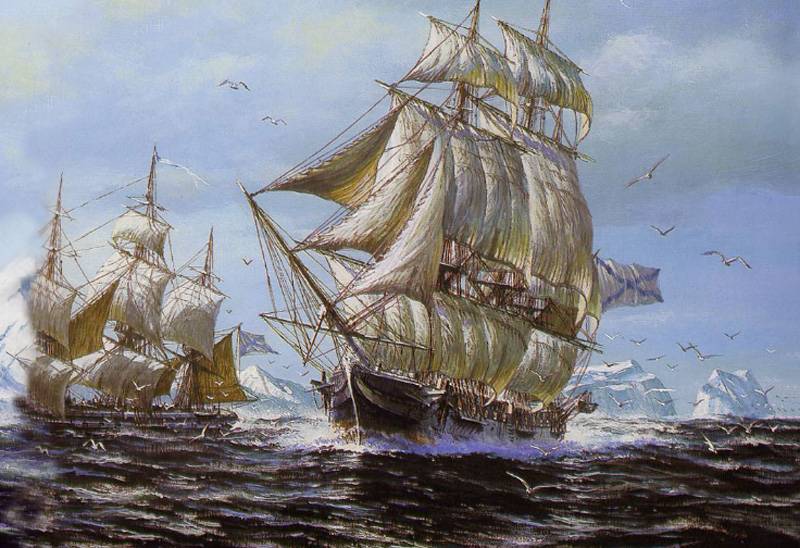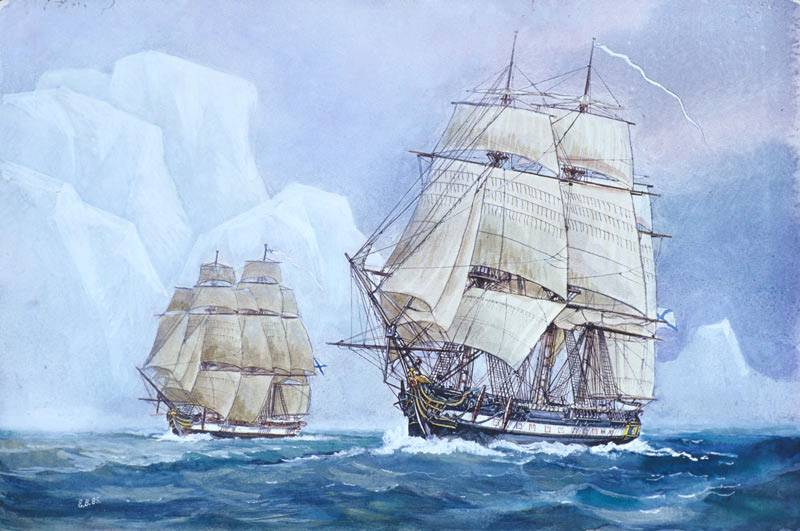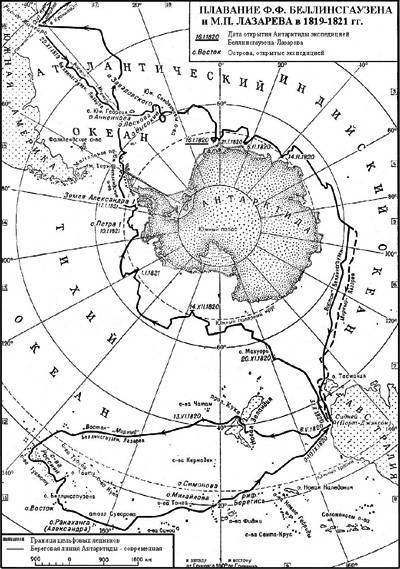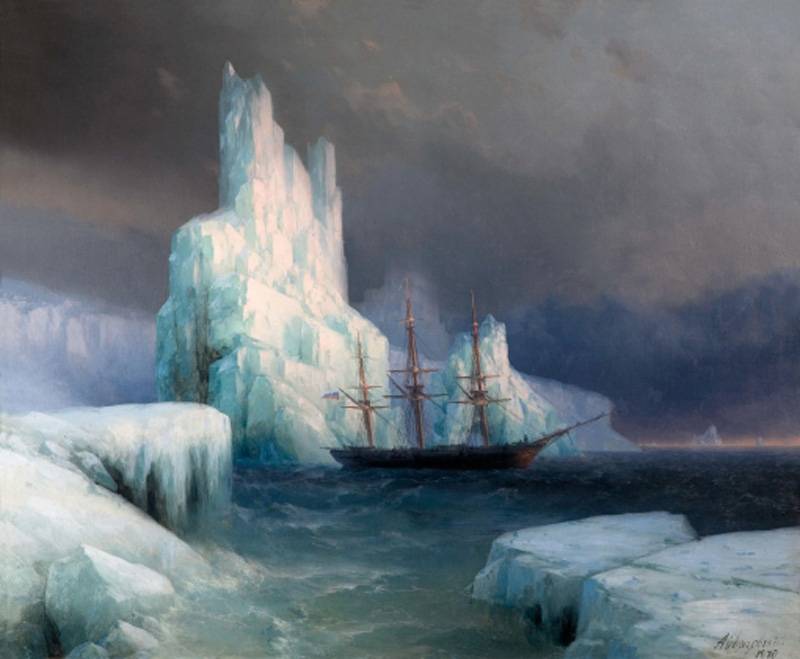The first Russian Antarctic expedition. Part of 2

South
Bellingshausen’s first goal was to call at Copenhagen, where the ships arrived ten days after sailing, July 14. According to the original plan, in the Danish capital it was planned not only to replenish some stocks, but also to take on board two German scientists who had been invited to the expedition in advance. However, there was some embarrassment: at the last moment, the pundits decided not to tempt fate and refused to participate in the enterprise. Perhaps they were dissuaded by skeptics, of whom there were many, who believed that there was no continent in the far south. It is likely that this was their personal decision.
The Russian sloops' mess-rooms complained about the fact that two Russian students were not allowed to participate in the expedition, they were not afraid of a long and dangerous voyage, or of the hardships associated with it. Preference was given to foreigners, who in the end did not want to use the opportunity so willingly given to them.
The next stop point was Misty Albion. 29 July 1819, East and Peace, anchored in Portsmouth. The same day, the sloops of the second, northern division, the “Well-intentioned” and the “Discovery”, arrived at this port. Portsmouth turned out to be a kind of meeting point for Russian expeditionary ships — during the time it was there, the Kamchatka sloop, commanded by Vasily Mikhailovich Golovnin, also returned from circumnavigation. The ship Kutuzov owned by the Russian-American company under the command of Lieutenant-Commander Leonty Andrianovich Gagemeister, which was returning home from Novoarkhangelsk in Alaska, also glanced into this harbor. Captain-Lieutenant Gagemeister served there as chief governor of the colonies.
This navigator, cartographer and researcher coped with his duties so well and effectively that the gnashing of the teeth of the local colonial bureaucracy filled with sincere fury was soon heard even in distant Petersburg. Administrative freemen were so accustomed to various “freedoms” far from the capital that they could not tolerate an honest and energetic leader over themselves. And Gagemeystera shifted.
In Portsmouth for the needs of the "East" and "Peace" were also made extensive purchases. In the first place, this concerned navigation equipment and instruments. In addition, new-fashioned then canned food was taken on board. By the way, among the cargoes available on both ships was also to some extent special. It was a rather impressive stock of glass beads, mirrors, jewelry, tools, fabrics and other souvenirs and gifts for residents of the islands of Oceania, who were to visit, and perhaps even discover.
In addition to the standard set of gifts, there were also a number of special medals. The silver ones were supposed to be given to the “personage important”, and the bronze ones - to all the rest. On all the medals, on the one hand, the profile of Alexander I was depicted, and on the other, the inscription “Sloops“ Vostok ”and“ Mirny ”and the date 1819. For special occasions 10 hussar jackets were stocked.
Contact with the local population was to be organized in the most constructive manner. Among the instructions received by the expedition, there was one that regulated relations with the natives, who should be treated "as friendly as possible."
"East" and "Peace" left Portsmouth August 26 (September 7) and went to the Atlantic. The first parking is the island of Tenerife. There was a regular operation to replenish the supply of fresh water and update the range of provisions. 2 (14) November, the ships Bellingshausen and Lazarev anchored in Rio de Janeiro. By this time there were already ahead of them "Discovery" and "Well-intentioned".
The newly encountered Russian ships now had to finally part - on November 22 (December 4) they left the Brazilian coast, and their courses diverged. "Well-intentioned" and "Discovery" went to the east, to the Cape of Good Hope, and "East" and "Peace" - in the Antarctic waters.
On November 24, the sloops of the southern division went astray. On board the "East" arrived Lieutenant Lazarev, several officers and a priest. A prayer service was held on asking for a safe voyage. After this ceremony, Lazarev received a salary from the Mirny team for 20 months and portioned money for the same period. Lazarev was instructed to stay away from “Vostok” in bad weather at a distance of no more than 5 cable, and in good weather - on the beam, at a distance not further than 8 miles.

The sloops were going south. 10 (22) December due to a significant decrease in temperature Bellingshausen ordered to place on the decks, in regular places, stoves for heating personnel. 15 (27) December Russian sailors saw the shores of the island of South Georgia. At one time he was examined by James Cook as part of his expedition to the southern latitudes. This time South Georgia underwent a more detailed study, several new capes and bays were mapped on the map, and Annenkov Island located nearby was discovered, named after the midshipman from Mirny.
December 22 from the ships was first seen a huge ice floe, which is located on a colony of penguins. In the following days, several more islands of volcanic origin were discovered. 25 December 1819 in a solemn ceremony marked the anniversary of the official expulsion of the Napoleonic army from Russia - the team received a festive dinner and additional portions of rum.
Moving southeast, the ships finally reached the so-called Sandwich Land, discovered by James Cook and named after the first Lord of the Admiralty of that period. It soon became clear that Sandwich Land is not one big island, but a whole group of small ones. One of them was initiated by Bellingshausen named Cook, and the whole archipelago received the name of the South Sandwich Islands.
3 January 1820 expedition was located near the island of South Tula. It was the closest land plot to the pole, which James Cook discovered in his time. Interestingly, in 1930, the British expedition aboard the Discovery II ship renamed South Tula to Bellingshausen Island.
The ships continued on their way, the amount of ice they encountered increased. At half past two in the morning of 9 in January of 1820, the “Peaceful” hit its nose on an ice floe and received a shake of the hull. There was no hole, and the damaged underwater hull area near the stem was subsequently repaired in Australia. January 15 1820 for the first time in stories Russian fleet the sloops “East” and “Mirny” crossed the Arctic Circle.
On January 28, in conditions of poor visibility from ships, the coast of the “icy continent” was fixed at a distance of about two miles. Heavy ice was getting in the way. It later emerged that this was the Coast of Princess Martha, the western part of Queen Maud Land, so named by the Norwegian expedition of Yalmar Rieser-Larsen in 1930 year. The author of the preface of Bellingshausen’s book on the expedition, Antarctic explorer France Debenham, wrote on this occasion that Bellingshausen "saw the mainland, but did not recognize it as such." Further, the English scientist continues: "It was impossible to give a better description of hundreds of miles of the Antarctic continent, as we now know it."
February 5 from the sloops again observed signs of land, but could not move forward because of the heavy ice situation. 4 March Faddey Faddeevich Bellingshausen decided to stop moving east along the coast of the icy continent and go to Australia. In addition, the Antarctic winter was approaching.
Now, Vostok and Mirny were supposed to follow separately from each other at a distance of approximately 120 – 125 miles. This was done to cover a larger study area. 5 (17) March, the ships parted, the meeting point was set in Port Jackson, Australia, with Sydney located in its waters.
9 (21) of March "Vostok" fell into a violent storm - its rigging was seriously damaged, and by the order of the commander, several sailor beds were stretched on the mizzen-guy to keep closer to the wind. The poorly controlled ship suffered a large ice floe that was inappropriately nearby, however, fortunately, the collision was avoided. To crown it all, the raging elements damaged the bowsprit, which, however, was soon corrected.
The storm eventually subsided, and the Vostok continued its voyage. March 27 (April 8) from its side was noticed the coast of Australia. At 11 o'clock in the morning 30 March 1820, the sloop anchored in Sydney roadstead.
Tropical respite
Since leaving Rio de Janeiro, 131 has passed a day. 7 (19) April in Sydney, finally, arrived and "Peace." After a short separation, both Russian ships were together again. A camp and a field observatory were deployed on the shore, where Simonov, a professor at Kazan University, conducted daily observations.
Near the observatory was equipped bath. For this purpose, a stove was built from the cast iron ballast on board in a large canvas tent. On this stove and with the help of red-hot kernels, water was heated, the tent was closed, and it was continuously poured over from the hoses so that the produced steam would not go out of the canvas.
In addition to worries about the arrangement on the shore, the team took up the repair of their ships. Lieutenant Lazarev led the "Peace" into the bay and at high water he put his nose on the shoreline. At low tide, the underwater part was exposed and it became possible to fix the damaged part of the hull around a stem about 1,35 meter long. After the completion of the work, Mirny was pulled away from the shoal, and the ship took its place in the roadstead.
An impressive amount of work was carried out in the "East" - it was heavily patted by the March storm. Easing as far as possible the bow tip, made repairs to the copper plating of the underwater part of the hull. The injured bowsprit was also strengthened.
When the repair work was completed, food and fresh water supplies were replenished, both Russian ships 8 (20) of May 1820 of the year went out to sea. Their path lay in the tropical Pacific Ocean, where it was planned to make the necessary research.
The Tasman Sea met “Vostok” and “Mirny” with a strong storm. The sloops were moving towards New Zealand. At the same time, Bellingshausen corrected the initial plans: instead of going around the northern extremity of this land, Faddey Faddeevich decided to move on to the little-studied Cook Strait that separated the North and South Islands of New Zealand.
The strait greeted the Russian ships with an inhospitable strong headwind, and they had to maneuver for about a week near its eastern exit. There was also quite friendly contact with the local population. To board the "East" moored the boat with the natives, from whom by exchange of trade was obtained fish, and themselves bestowed them with all sorts of gifts and food. Russian officers noted that the islanders practically did not drink alcohol.
Only 10 (22) of June the sloops left behind the Cook Strait as a stern and headed for Rapa Island, located in southern Polynesia, discovered in 1791 by English explorer George Vancouver. After specifying the arrival of its coordinates, "East" and "Peace" moved to the archipelago of Tuamotu. There were discovered, described and mapped a number of islands, named after the Russian generals, naval commanders and statesmen. Among others, the islands of Kutuzov, Barclay de Tolly, Arakcheev, Greig, Chichagov and others were discovered.
One island was named after Rear Admiral Moller - he once held a flag on a frigate commanded by Bellingsgausen. When attempting to land on this site of land, Russian sailors encountered on the shore local people, not at all with better hospitality. They willingly took gifts, which they threw from a boat standing at the shore, but did not give the opportunity to stick. To speed up the process of dating over the heads of local residents, several shots were fired, but, seeing that the aliens did not cause them any harm, the aborigines again began to "rally".
In the end, a blank cannon shot was fired from Mirny - having recovered from the horror, the natives again refused to receive guests. That, however, did not prevent them from happily ringing with donated bells. As a result, Bellingshausen, who was personally in the boat, gave the order to return to the ship. There was no question of shooting to kill or even causing any damage to the islanders, and such options were not even considered. All this part of the Tuamotu archipelago was named Bellingshausen by the Russians archipelago.
22 July 1820, both ships anchored in Matawai Bay, located on the island of Tahiti. There was a routine procedure for the replenishment of stocks of supplies and fresh water, after which July 27 sloops again went into the ocean. During this period, Russian sailors discovered and mapped fifteen previously unknown islands, which received the name of the Alexander Archipelago.
Having completed a large amount of geographic work, the September 10 expedition returned to Port Jackson Bay. This time the ships stayed in this place for fifty days. Much attention was paid to the repair of "Vostok", which in general was in a less acceptable condition than "Mirny". However, later this difference will only increase, and not in favor of the flagship. In the "East" was repaired and strengthened the body, once again strengthened mounting bowsprit injured in March.
Attitude to the Russian sailors of the local governor Lachlan Macquarie was generally favorable. Under his order, materials for the repair of ships and workers were allocated from local resources. Officers from both sloops were so often invited to dinner parties and evenings that, according to Bellingshausen, this courtesy harmed the course of current affairs.
And south again

On October 31 (November 20) the sloops left the parking lot in Port Jackson Bay and moved south-east. Already after a few days of being in the ocean in the underwater part of the "East", the leak opened, but Bellingshausen, having analyzed the situation, decided to continue sailing. 17 (29) November ships came to the island of Macquarie, located to the southeast of Tasmania. This island was opened in 1810 by the English and was named in honor of the Governor General of the province of New South Wales Laclan Macquarie, who had rendered so kind assistance to the crews of Vostok and Mirny.
A landing was carried out to inspect this land plot. Fresh water was replenished, a number of birds that were fit for human consumption were shot. A group of industrialists engaged in hunting for sea animals was found on the island — they were given a supply of food, because the ship that was supposed to deliver the substitute was delayed.
November 17 felt two strong shocks in the “East” in mind of the island. Depth measurements, showing a mark of over a hundred meters, excluded contact with the bottom, grounding or reef. Soon a boat arrived with “Mirny” with Lieutenant Annenkov, who reported that two shocks were felt on the second sloop. From all this it was concluded that in this case there was an underwater earthquake.
On November 19, the expedition’s ships again approached Macquarie Island with the aim of receiving the elephant skin for the St. Petersburg Museum from local industrialists, which they promised to prepare.
At last the land was left astern, and the sloops continued on their way south. 28 November 1820, the sailors again saw icebergs - they were met by the Antarctic. On November 29, one of the icy mountains was inspected on a boat and ice samples were taken. November 31 before the "East" and "Peace" was a continuous strip of ice - the ships moved along it, trying to find the passages to the south.
December 1 on the ice floes, in abundance floating around the ships, were seen birds, whose habitat was the land. 13 (25) December sloops crossed the Southern Arctic Circle for the fourth time. On December 15, while examining a large royal penguin killed on the ice, several small pebbles were found in his stomach.
Swimming took place in very difficult conditions: poor visibility, winds with snow, plenty of floating ice and icebergs. Due to the large amount of firewood harvested in Australia, it was possible to constantly heat the interior of the ship. Crushed ice was widely used to save fresh water when cooking. As an additional antiscorbutic agent, the crew were given out orange juice and barrels, like the classic cucumbers, lemons.

The flow in the "East" constantly reminded of itself by regularly pumping out water. To facilitate the sloop, Bellingshausen ordered to remove two guns from the battery deck and lower them into the hold.
10 January 1821, the sloops reached the southernmost mark of their voyage during the whole expedition: 69 degrees 53 minutes south latitude and 92 degrees 19 minutes west longitude. At three o'clock in the afternoon, the long-awaited land was noticed in the telescopes. This news was transmitted by the flag telegraph to Mirny, and they answered that they were also observing the land. In a few hours, it will be a rocky island. The joyous event was marked by a cannon salute and a triple “Hurray!”. The island got its name, as Bellingshausen wrote, in honor of the "culprit in the existence of the Russian military fleet" of Emperor Peter I. He had around 25 miles around. Going close to the shore, however, did not allow solid ice.
Bellingshausen quite definitely suggested that an open island cannot be only a single piece of land on such a long stretch of sea, other islands must be located nearby and, quite acceptable, the mainland. "East" and "Peace" slowly and carefully moved to the south-east. The number of birds encountered along the way increased, and this was another sign of the proximity of the earth.
January 17 The 1821 of the year, in conditions of good lighting at 11 hours of the day, was spotted on the shore. It was a cape, topped with a high mountain. The terrain was rocky, covered with snow. The open land was named after Alexander I. Due to the deteriorating weather and unfavorable ice conditions, it was not possible to get closer than a few miles to Alexander I Land. However, the main thing was done: in the far southern latitudes, an impressive land massif was discovered, which made it possible to assert the existence of a previously unknown continent.
Return
From the coast of Alexander I the ships headed for the north-west. Bellingshausen decided to explore the so-called New Shetland, the discovery of which he learned while in Port Jackson, from a letter from the Russian envoy to Brazil. The ambassador notified that at the beginning of 1819, the Englishman Smith, bending around Tierra del Fuego, was blown away by the winds to the 63 parallel and there he discovered the land, which he called South Shetland. Bellingshausen decided to clarify and verify this information, going to the marked land on the south side.
January 24 (February 5) "East" and "Peace" approached the so-called South Shetland, which in fact turned out to be not a large land, but a group of islands. Over the course of several days, a number of islands were mapped, named after the battles of the 1812 war of the year, the campaigns of 1813 and 1815. (one island was recorded as Waterloo).
Northeast of the South Shetland Islands, new discoveries were made. A previously unknown group of three islands, known as the Three Brothers, was discovered. 3 (15) February 1821 of the year near South Georgia Island "East" and "Peace" crossed the meridians of St. Petersburg, thereby closing the circular route, passed around the globe. The expedition has become around the world.
February 4 ships hit a heavy storm. The “East” got more than the “Peace”, and if it were not for the repair of pumps the day before, the position of the flagship sloop would have been very difficult. Its flow intensified, and the incoming water had to be constantly pumped out.
February 28 ships anchored in the bay of Rio de Janeiro. In this harbor, there was a procedure for treating "Vostok", since his condition caused concern. The copper plating in the bow was removed, the hull was carefully cleaned, after which the sheets of copper were re-installed. Other repairs were carried out. After the teams had sufficiently rested from heavy navigation in Antarctic waters, fresh provisions and water supplies were loaded, 23 April 1821, the Russian sloops left the Brazilian coast.
17 June from the ships saw Cape Roca, the most western cape of Eurasia, located in Portugal. On the same day, they entered the Tagus River and dropped anchors in Lisbon. On June 28, after the next replenishment, Bellingshausen and Lazarev brought their ships to the sea - it was decided to go immediately to Russia.
On July 24, the sloops Vostok and Mirny reached Kronstadt and, having saluted the fortresses, anchored in the place from which they had set off two years ago. The expedition lasted 751 day, of which 527 days spent at sea. In the ice "East" and "Peace" spent 100 days. During this time, the ships traveled 49860 miles. Russian sailors, except for the previously unknown "ice continent", opened twenty-seven unknown islands, one coral atoll. Extensive observations and research were conducted in various fields of science, and numerous samples of the flora, fauna and household items of peoples living on the islands of the Pacific Ocean were collected.
In 1824, Faddey Faddeevich Bellingsgausen finished the work on the book “Double Surveys in the Southern Ocean and Sailing the Vostok and Mirny Sluts around the World. Due to various bureaucratic delays, this unique work was published only in 1831, in an edition of 600 copies. It is remarkable that the maps for his book Bellingshausen traced himself. Numerous illustrations were made by the expedition member Pavel Mikhailov. Bellingshausen’s book, which, upon returning to Russia, was promoted to captain 1 rank, and soon to captain commander, was translated into many foreign languages.
The commander of the sloop "Mirny", Mikhail Petrovich Lazarev, was promoted to captain of 2 rank, bypassing the rank of lieutenant commander. He was awaited by the deck of the frigate Cruiser, the fire of Navarin and the command of the Black Sea Fleet.
Information